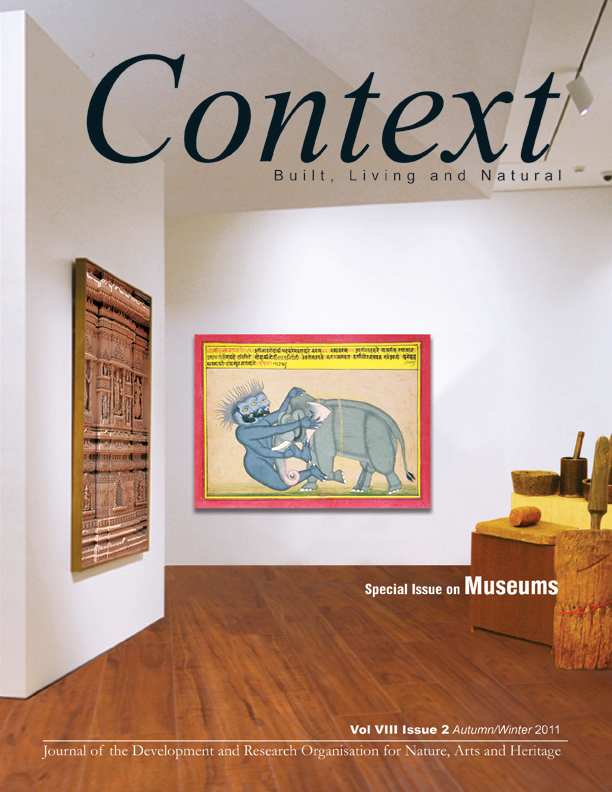Special Issue on Museums : Volume VIII Issue II
About the Volume
There is a palpable sense around us these days that our museums in India are going to change, that there is an impending Renaissance. This volume attempts to capture the important moment as we prepare ourselves to make the transition to a different kind of a museum dialogue; one that goes beyond just grand buildings housing precious objects. This collection of essays represents the museum in India in all its exhaustive and expansive potential including tangible objects, intangible cultural heritage, urban spaces, communities, performances, collections, archives and life narratives.
The first section on communities brings the focus of the museum back to people’s memories, lived experiences and articulation of identities. Troubling events in contemporary India, like the India-Pakistan partition and the Bhopal gas tragedy, raise questions about the promise and perils of museumising contentious events, as written by Urvashi Butalia, Moulshri Joshi and Amritha Ballal. But this conversation also offers us, in India, an opportunity to dismantle the high-culture-low-culture divide prevalent in our museums and forces the museums to engage with difficult narratives.
The traditional notion of a museum has expanded over the decades to include intangible cultural heritage found in oral histories, ethnic identities and urban habitats grappling with change. The demolition and translocation of flower markets of New Delhi marks a loss of cultures built around certain livelihoods, faith and urban lifestyles. This is a culture that is invisibilised by the Indian capital’s frenetic march toward becoming a 21st century super-city. The Dastangoi tradition, the Mughal art of storytelling, which has now found an exciting revival is not only an intangible cultural artefact but can also easily tie into the performative teaching techniques in a museum. As Elizabeth Pickard writes, gallery theatre can also be a rich way of facilitating visitors’ meaning-making processes.
Indian museums have paid scant attention to visitors’ comfort and experience. Visitor studies are only now taking off in India, but Andrew Pekarik warns us that visitors cannot be viewed as passive receptacles. Deepti Mulgund writes about how a new contemporary art museum in a mall frames the visitor in the context of conspicuous consumption. Abha Negi presents the glaring and acute apathy toward visitors in denial of universal access to people with physical, cognitive and developmental disabilities, at historic monuments and museums, and highlights initiatives undertaken to close the gap.
In the past five years, new kinds of exhibition themes such as archival photographs, corporate memory, urban transport infrastructure, manuscripts and newer audiences have presented unique curatorial challenges. Diverse museum audiences visiting Indian exhibitions in the United States present their own set of questions about curator Vidya Dehejia’s hybrid ethnic identity and perspective.
Finally, the planning and maintenance of museums, and turning them into efficient and profitable entities requires a wide range of professional expertise. How we train and produce these skilled professionals needs to be constantly reviewed by scholars to bridge the gap between the academia and the industry.
- Editorial team
Contents
About the Volume
Editorial
Rama Lakshmi
Museum and the Community
Bhopal Gas Tragedy Dissonant history, difficult heritage
Moulshri Joshi and Amritha Ballal
Engaging with Public History
Indira Chowdhury
Confronting the Past Thoughts on a Partition Museum
Urvashi Butalia
Mapping Social Identities
Minja Yang
Dastangoi Revival of the Mughal art of storytelling
Mahmood Farooqui
Beyond the Object Changing museum discourse
Marie Eve Celio-Scheurer and Moe Chiba
Living Museums Understanding our urban spaces
Himanshu Verma
Museums and Visitors
Recasting the Visitors From passive consumers to active agents
Andrew J Pekarik
Museum Theatre Living connections to exhibits
Elizabeth Pickard
Access to History Making design universal
Abha Negi
Museum in the Mall Visitors as art consumers
Deepti Mulgund
Curatorial Voices: Changes and Challenges
Projecting India Museum displays in the United States
Vidya Dehejia
An Unclaimed Legacy Examining and exhibiting photographic archives in India
Pramod Kumar KG
Indian Manuscripts Displaying intellectual history
Sudha Gopalakrishnan
Delhi Metro Museum The chronicler of a new age revolution
Anuj Dayal
Archiving Corporate Memory
Vrunda Pathare
Museum Planning and Maintenance
Museum Planning in India
Barry Lord
Demystifying Documentation - Mrinalini Venkateswaran
Retailing Cultural Merchandise
Maureen Liebl
Heritage Orphanages Site museums
Amita Baig
Managing Museums
Sadashiv Gorakshkar
Teaching Museology in India
Manvi Seth
Museum Album
This section includes visuals of few unique and representative museums across India:
Indira Gandhi Rashtriya Manav Sangrahalaya, Bhopal
Anokhi Museum of Hand Printing, Jaipur
Calico Museum of Textiles, Ahmedabad
Akshardham, New Delhi
Kite Museum, Ahmedabad
Sulabh International Museum of Toilets, New Delhi
Dharohar Haryana Museum, Kurukshetra
Museum of Folk Culture, Jodhpur
Culture Conscious Design and Museum Interactions by Ranjit Makkuni
Book Reviews
Reviewed by Rama Lakshmi
The Participatory Museum by Nina Simon
Beyond the Turnstile: Making the Case for Museums and Sustainable Values by Selma Holo and Mari-Tere Alvarez
Reviews
Scheme for Financial Assistance for Setting Up, Promotion and Strengthening of Regional and Local Museums
Reviewed by Shikha Jain
Status of the Government Museums Excerpts from Parliamentary Committee Reports

